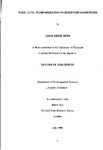PORE-LEVEL FLUID MIGRATION IN RESERVOIR SANDSTONES
| dc.contributor.author | MOSS, ADAM KEITH | |
| dc.contributor.other | School of Geography, Earth and Environmental Sciences | en_US |
| dc.date.accessioned | 2013-09-16T08:37:28Z | |
| dc.date.available | 2013-09-16T08:37:28Z | |
| dc.date.issued | 1994 | |
| dc.identifier | NOT AVAILABLE | en_US |
| dc.identifier.uri | http://hdl.handle.net/10026.1/1722 | |
| dc.description.abstract |
The void space properties of a set of gas reservoir sandstone samples have been measured. The properties include porosity, absolute gas permeability, electrical resistivity formation factor and tortuosity. The mineralogy of each sandstone was determined by scanning electron microscopy and energy dispersive x-ray analysis. Mercury intrusion and extrusion data have been measured for most of the sandstone samples. A new procedure for measuring the degree and range of void size correlations within resin-filled sandstones has been developed. Image analysis of backscattered electron micrographs of these samples supplies void size and positional information. A "semi-variogram" study of void size and coordinate data ascertains the degree and range of void size correlation. Measurable correlation has been found in two sandstone samples, but was absent from four others. Diffusion coefficients of methane, iso-butane and n-butane through dry sandstones have been measured using an adaptation of a non-steady state method, using a redesigned apparatus. A repeatability and error analysis of diffusion coefficient measurement has also been performed. A correlation between diffusion coefficients, absolute permeability, porosity and formation factor was detected for sandstones containing little clay. The diffusion coefficients measured for clay affected sandstones did not correlate with any petrophysical properties of these samples. A computer model capable of simulating porous media has been previously developed. It consists of a 10x10x10 network of cubic pores and cylindrical throats, and simulates die mercury intrusion curve. The void size distribution is modified until both simulated and experimental curves closely match. New void size distribution input and curve fit algorithms have been developed to increase the speed and accuracy of die simulations and a new modelling procedure allows the modelling of samples with void size correlation. The model is capable of simulating porosity, permeability, tortuosity and mercury extrusion. Each of the reservoir sandstones has been modelled and their characteristic properties simulated. Successful simulations were obtained for all relatively clay-free reservoir sandstones. Clay affected sandstone simulations were less successful due to the high complexity of these samples. A study into formation damage witiiin reservoir sandstones was also undertaken. The effect of colloidal particulate void space penetration is measured and simulated. | en_US |
| dc.description.sponsorship | British Gas, Michael Road Research Station, London | en_US |
| dc.language.iso | en | en_US |
| dc.publisher | University of Plymouth | en_US |
| dc.title | PORE-LEVEL FLUID MIGRATION IN RESERVOIR SANDSTONES | en_US |
| dc.type | Thesis | |
| plymouth.version | Full version | en_US |
| dc.identifier.doi | http://dx.doi.org/10.24382/3669 | |
| dc.identifier.doi | http://dx.doi.org/10.24382/3669 |
Files in this item
This item appears in the following Collection(s)
-
01 Research Theses Main Collection
Research Theses Main


